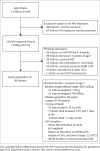Peripartum HIV infection in very low birth weight infants fed 'raw' mother's own milk
- PMID: 31308967
- PMCID: PMC6620524
- DOI: 10.4102/sajhivmed.v20i1.912
Peripartum HIV infection in very low birth weight infants fed 'raw' mother's own milk
Abstract
Background: HIV-exposed very low birth weight (VLBW) infants (≤ 1500 g) are considered at high risk of peripartum mother-to-child HIV transmission (MTCT). In the past, they received formula to prevent breast milk related HIV transmission. This denied them the benefits of breast milk, thus exposing the infant to the risk of necrotising enterocolitis (NEC). From 2010, 'raw' mother's own milk (rMOM) has been recommended for term infants whose mothers' received antenatal antiretroviral therapy (ART). At the same time, the infant received antiretroviral (ARV) prophylaxis as per the National Prevention of MTCT programme.
Objectives: To determine the cumulative incidence of peripartum HIV infection by 4-6 weeks of age in HIV-exposed VLBW infants, who received rMOM and infant ARV prophylaxis.
Method: A retrospective, observational audit over 3 years at a single institution was undertaken. The study population comprised HIV-exposed VLBW infants who received both nevirapine prophylaxis and rMOM from birth until discharge. A positive HIV-PCR by 4-6 weeks of life was used to confirm maternal to infant HIV transmission.
Results: Of the 80 eligible infants admitted between 2010 and 2013, 63 (79%) were exposed to antenatal ART. Seventy-eight (97.5%) tested HIV-PCR negative at 4-6 weeks. Of the two infants who tested positive, both presented with features of an acute HIV infection. The absence of MTCT in the remaining 78 infants given ARV prophylaxis and rMOM suggests that rMOM is an unlikely source of infection in the two infected infants.
Conclusion: rMOM, in the presence of infant prophylaxis, was a safe feeding option for HIV-exposed VLBW infants. It should be strongly considered for these infants, as rMOM likely provides additional maternal and child benefits.
Keywords: HIV; Mother-to-child transmission; Mother’s own milk; Nevirapine; Peripartum transmission; Prevention of mother-to-child transmission; Raw breast milk; Very low birth weight.
Conflict of interest statement
The authors declare that they have no financial or personal relationship(s) that may have inappropriately influenced them in writing this article.
Figures
Similar articles
-
Independent of Birth Mode or Gestational Age, Very-Low-Birth-Weight Infants Fed Their Mothers' Milk Rapidly Develop Personalized Microbiotas Low in Bifidobacterium.J Nutr. 2018 Mar 1;148(3):326-335. doi: 10.1093/jn/nxx071. J Nutr. 2018. PMID: 29546315
-
National-level effectiveness of ART to prevent early mother to child transmission of HIV in Namibia.PLoS One. 2020 Nov 10;15(11):e0233341. doi: 10.1371/journal.pone.0233341. eCollection 2020. PLoS One. 2020. PMID: 33170840 Free PMC article.
-
Effect of Donor Milk on Severe Infections and Mortality in Very Low-Birth-Weight Infants: The Early Nutrition Study Randomized Clinical Trial.JAMA Pediatr. 2016 Jul 1;170(7):654-61. doi: 10.1001/jamapediatrics.2016.0183. JAMA Pediatr. 2016. PMID: 27135598 Clinical Trial.
-
Prevention of mother-to-child transmission of HIV--what next?J Acquir Immune Defic Syndr. 2003 Sep;34 Suppl 1:S67-72. doi: 10.1097/00126334-200309011-00010. J Acquir Immune Defic Syndr. 2003. PMID: 14562860 Review.
-
HIV transmission through breastfeeding: problems and prevention.Ann Trop Paediatr. 2003 Jun;23(2):91-106. doi: 10.1179/027249303235002161. Ann Trop Paediatr. 2003. PMID: 12803739 Review.
References
-
- Department of Health South Africa. The 2015 national antenatal sentinel HIV & syphilis survey report [homepage on the Internet]. 2015 [cited 2019 Apr 7]. Available from: http://www.health.gov.za/index.php/shortcodes/2015-03-29-10-42-47/2015-0....
LinkOut - more resources
Full Text Sources
Miscellaneous



